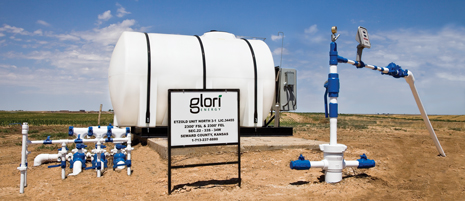Innovative thinkers
Glori Energy: EOR goes green
|
Each year, oil-producing fields around the world inch closer and closer toward maturity, as production levels begin to naturally, and expectedly, decline. In the past, operators and oilfield service providers have done their best to extend the lives of reservoirs, hoping to recover as much oil as possible through traditional EOR methods. But, what some companies may see as the end of a field’s life, the Glori Energy team sees as just the beginning.
Through R&D collaboration agreements, Glori’s scientists leveraged decades of work from Statoil, Argentina’s Biotopics and India’s The Energy and Resources Institute (TERI), to develop their microbial EOR technology. The company’s AERO System (Activated Environment for Recovery of Oil) helps reservoirs help themselves, by stimulating the naturally-occurring microbes found in subsurface formations. With AERO, nutrients, such as nitrogen, phosphorus or trace metals, are injected into a formation, to promote microbial activity in two distinct patterns. First, as the microbes consume oil, a nutritional carbon source, they begin to act as a surfactant, relieving interfacial tension between water and oil, allowing the oil to move toward the producing well. Second, as the microbes consume energy, growing and dying along the way, they create biomass, which becomes trapped in the formations, blocking pores, and creating new fluid pathways. Dr. Michael Pavia, Glori’s chief technology officer, said the system’s success is due, in part, to the company’s holistic approach, where chemistry, microbiology, reservoir engineering, geology and field operations all play a role. While the concept of using microbes to stimulate oil and water movement in formations has been around for several decades, historic approaches “have not gone very well.” Today, the AERO System is able to return incremental oil because it focuses on more than just the microbial mechanism. “You have to have a very detailed knowledge of, not only the microbes, the nutrients and the environment, but also the reservoir geology, from a reservoir engineering perspective,” said Pavia. Dr. Pavia said that carefully controlled experience in the field was an essential part of the system’s technological development, which spanned five years. With the combined expertise and experience of Glori, TERI, Biotopics and Statoil, AERO incorporates roughly 60 years of research. Prior implementations of microbial EOR by these groups led to the recovery of more than 6 million bbl of oil in global projects, and positive field testing in the North Sea, Austria and Argentina. Now that Glori has brought its system to market, Pavia said the company has approximately a dozen active projects in the field throughout the world. The AERO System was developed to mobilize residual oil in sandstone reservoirs with conventional oil, in fields under waterflood. Dr. Pavia said the company is in the process of identifying oil fields to purchase, and in which the AERO System can be deployed. For operators, the AERO System is a meeting between economics and environment. Glori’s microbial EOR system has a reduced capital expense, roughly $100,000 versus the $40-million price tag of a CO₂ or thermal project, and can return incremental oil at under $10 per barrel, compared to the $40 cost in traditional models. Additionally, produced water sampling has shown no traces of the microbes or nutrients used in the system reaching the producer wells. The Glori team has taken a relatively green, environmentally conscious approach to EOR, in some decidedly non-green, brownfield formations. As such, Glori has harnessed the power of nature to produce big results. |



